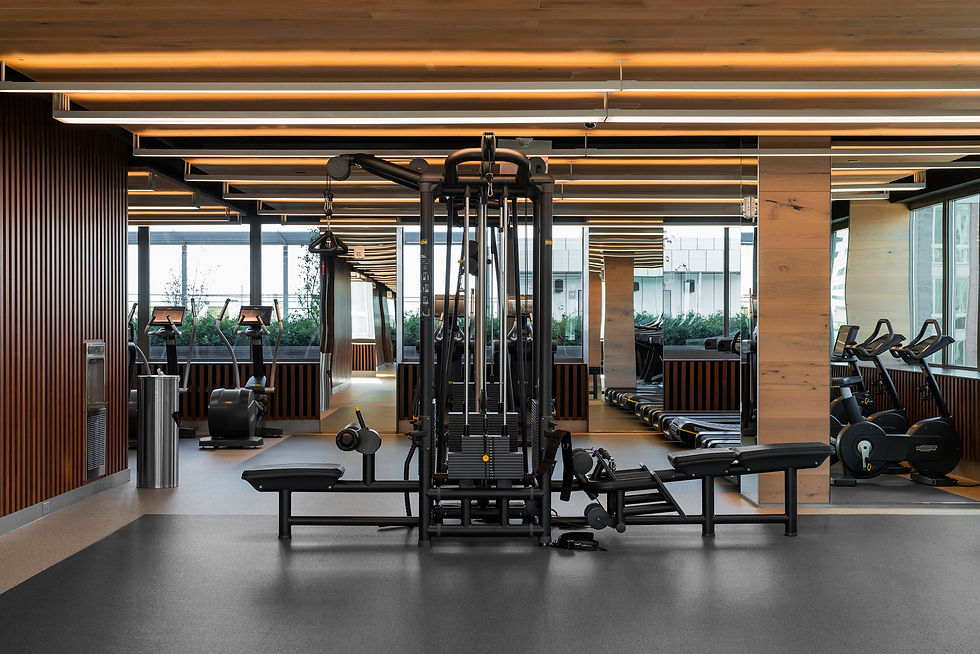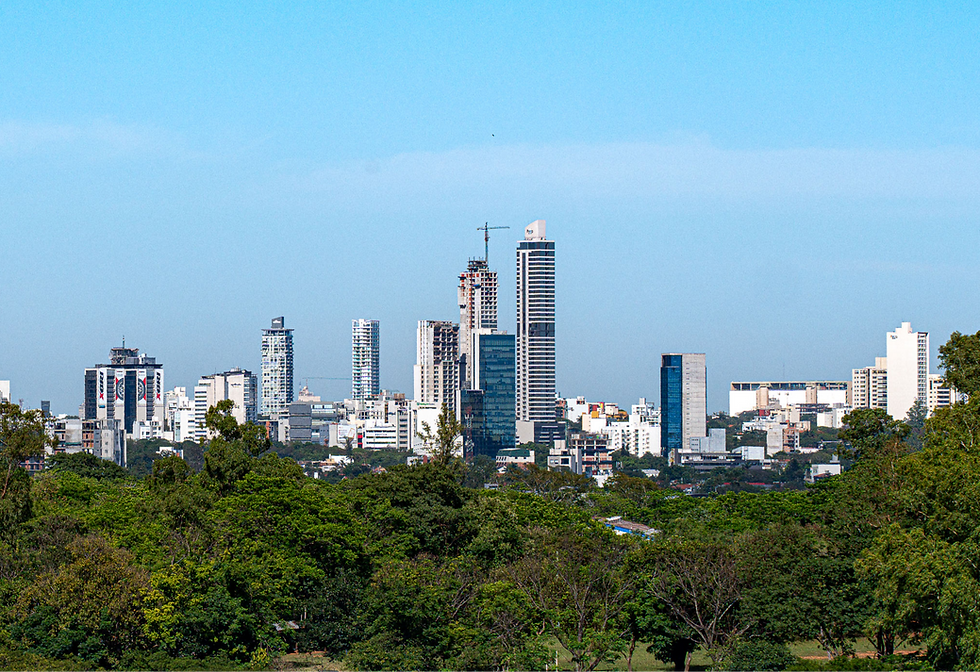Asunción or the Outskirts?: The Dilemma of Those Seeking Homeownership in a Changing Market
- Carlos E. Gimenez

- Jul 3
- 6 min read
Updated: Jul 8
The rise of high-rise buildings in Asunción and the sustained growth of gated communities on the outskirts pose an increasingly common choice among buyers: invest in the city or opt for land in suburban areas.

With the rise of high-rise buildings in Asunción and the increasingly sophisticated development of suburban subdivisions, the question many Paraguayan families are asking today is as simple as it is momentous: is it better to buy a house in Asunción or invest in land to build on in the outskirts? This dilemma is no longer limited to the price per square meter, but opens up a range of criteria linked to quality of life, infrastructure, access to services, and projected appreciation.
Areas such as Luque, Limpio, Mariano Roque Alonso, and Nueva Asunción have established themselves as epicenters of suburban expansion, with gated communities that incorporate urban design, first-class amenities, and community. Meanwhile, Asunción remains the most important institutional, employment, educational, and cultural hub in the country. Both alternatives have advantages and challenges that are worth examining in detail.
Living in Asunción continues to offer a significant advantage in terms of location and proximity to major employment, healthcare, education, and service centers. The capital is home to most corporate offices, law firms, government agencies, banks, private clinics, prestigious universities, and colleges. Neighborhoods such as Villa Morra, Recoleta, Las Lomas, and Ycua Satí allow for easy commutes and everyday life.

This proximity is no small feat: city dwellers can avoid long commutes during rush hour, when a trip from areas like Limpio or Mariano Roque Alonso to the Shopping del Sol can take between 20 and 35 minutes. Furthermore, Asunción offers better internet connectivity (especially through fiber optic coverage), greater coverage of mobility platforms like Uber and Bolt, more efficient logistics services, and quick access to delivery services for virtually any product.
On the other hand, peripheral developments have substantially improved their value proposition in recent years. Gated communities in Luque, Mariano R. Alonso, Limpio, and Nueva Asunción now boast high-quality infrastructure: paved streets, uniform sidewalks, underground cabling, meticulous landscaping, 24-hour private security, and comprehensive urban planning. Some even include natural lagoons, yacht clubs, sports fields, 24-hour supermarkets, or crystalline lagoons with Crystal Lagoons technology.
These developments respond to a growing demand from those seeking greater tranquility, contact with nature, and a more subdued family life. Furthermore, prices remain very competitive: in Mariano Roque Alonso and Limpio, lots can be purchased from USD 100 to 130 per m²; in Luque, where there are already established and functioning gated communities, prices range between USD 225 and 300 per m², depending on location and level of infrastructure; while in Nueva Asunción, projects in their initial stages can be found from USD 150 per m², reaching USD 300 per m² in developments close to opening. In comparison, in established neighborhoods of Asunción, it is difficult to find lots for less than USD 500 per m², and in some neighborhoods, prices even exceed USD 1,000 per m², particularly in areas with high demand and good connectivity.

Asunción continues to offer opportunities for appreciation, especially in areas where urban planning regulations are becoming more flexible and allowing for new vertical developments. Many plots of land are currently being marketed for their construction potential rather than their current use. For buyers with an investment profile, certain areas of the capital still represent a solid long-term option.
However, the outskirts also show signs of sustained appreciation. The creation of associations such as Distrito Norte—made up of developers working in coordination with the municipalities of Luque, Limpio, and Mariano Roque Alonso—aims to improve the surrounding urban infrastructure, raising overall standards and attracting new investment. This shared vision increases buyer confidence and contributes to a more structured appreciation of land.
An important practical difference is the availability of finished homes. While ready-to-move-in homes can still be found in Asunción, in suburban areas most listings are for land. Only in gated communities in Luque are there options for pre-built homes. In the rest of the outlying areas, the predominant option is self-construction or through partnerships with developers.
This involves taking on design, construction, permitting, and deadline processes, which can be an advantage in terms of customization, but also a challenge for those who need to move in the short term.
The capital offers a vibrant urban lifestyle, with access to restaurants, cafes, museums, galleries, cinemas, and shopping centers. Neighborhoods such as Las Mercedes, Recoleta, Villa Morra, and the Corporativo neighborhood have experienced a cultural renaissance that nourishes social life and diversity.

For their part, gated communities on the outskirts encourage a more peaceful lifestyle, focused on security, recreation, and neighborhood harmony. The design of these developments seeks to allow residents to engage in recreational, sports, or social activities without leaving the neighborhood perimeter. Community and a sense of belonging are central to this proposal.
Although plans are already underway to establish satellite hospitals, new schools, and eventually university campuses in areas such as Limpio and Mariano Roque Alonso, many of these projects are still in the development phase. This forces many families to continue relying on Asunción to cover essential healthcare and education needs. However, the recent opening of Maple Bear School in 2024 marked a turning point for the area's educational landscape. The institution, part of an international network with standards of excellence, will grow progressively: in the 2025/2026 school year, its primary section will open with Year 1, for six-year-olds, and will continue to add grades year after year until completing the full curriculum up to Year 12.
While the city offers structural advantages, it also suffers from chronic problems: severe traffic congestion, high land costs, growing insecurity, outdated infrastructure, and environmental pollution. Construction pressure in traditional residential neighborhoods has generated conflicts over buildings that affect privacy, lighting, and the tranquility of the surroundings.
In many areas, sewage systems, stormwater drainage systems, and pavements show levels of deterioration that directly affect residential comfort. This lack of maintenance and planning contributes to a negative perception of urban livability.
Another key attraction of peripheral areas is the possibility of accessing land "in progress," that is, in the early stages of development. This option allows buyers to acquire lots at significantly lower prices, with short- or medium-term financing plans, often interest-free. For those planning their future home, it represents a unique opportunity: there's no need to make a large initial outlay; instead, they can begin building their life plan step by step. Buying a large lot today, surrounded by nature and in a neighborhood with quality amenities, opens the door to building—in three, four, five, or six years—the home of their dreams in a planned environment, with security, community, and access to recreational services without leaving the neighborhood.

In addition to early access to lower prices, one of the great advantages of investing in the outskirts is the possibility of acquiring larger lots in naturally wooded settings, where urban design seeks to preserve both order and privacy. Unlike many traditional neighborhoods in Asunción—where land values encourage the construction of high-rise buildings even in residential areas—suburban subdivisions impose clear regulations regarding density, height, and land use. This gives homeowners the peace of mind of knowing that, when building their home, their quality of life will not be affected by adjacent towers that create shade, noise, or a loss of privacy. This predictability in the surroundings is one of the most valued elements by those planning their long-term homes.
The choice between a house in Asunción or a plot of land in the suburbs is no longer determined solely by price per square meter. It's a decision that must consider lifestyle, family life, financial availability, time horizon, and personal appreciation for community, connectivity, and surroundings.
For the first time, suburban areas are competing on a more level playing field against the capital city. Their proposal is not based solely on savings, but on a new housing model that integrates design, security, nature, and community life. Meanwhile, Asunción remains the densest functional node in the country, but faces structural challenges that must be taken into account.
Both options offer value. The difference lies in what each family is looking to build as a home.
If you're considering purchasing a home in Asunción or investing in land in the outskirts and want to explore specific options based on your needs, you can complete the following form:


